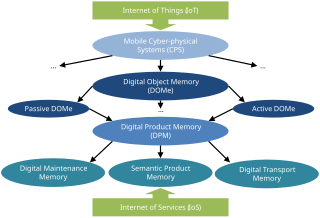Related Research Articles

Cyberspace is a concept describing a widespread interconnected digital technology. "The expression dates back from the first decade of the diffusion of the internet. It refers to the online world as a world 'apart', as distinct from everyday reality. In cyberspace people can hide behind fake identities, as in the famous The New Yorker cartoon." The term entered popular culture from science fiction and the arts but is now used by technology strategists, security professionals, government, military and industry leaders and entrepreneurs to describe the domain of the global technology environment, commonly defined as standing for the global network of interdependent information technology infrastructures, telecommunications networks and computer processing systems. Others consider cyberspace to be just a notional environment in which communication over computer networks occurs. The word became popular in the 1990s when the use of the Internet, networking, and digital communication were all growing dramatically; the term cyberspace was able to represent the many new ideas and phenomena that were emerging.
In software engineering, multitier architecture is a client–server architecture in which presentation, application processing and data management functions are physically separated. The most widespread use of multitier architecture is the three-tier architecture.
Privacy is the ability of an individual or group to seclude themselves or information about themselves, and thereby express themselves selectively.

The World Wide Web (WWW), commonly known as the Web, is an information system enabling documents and other web resources to be accessed over the Internet.

A website is a collection of web pages and related content that is identified by a common domain name and published on at least one web server. Examples of notable websites are Google, Facebook, Amazon, and Wikipedia.
Web design encompasses many different skills and disciplines in the production and maintenance of websites. The different areas of web design include web graphic design; user interface design ; authoring, including standardised code and proprietary software; user experience design ; and search engine optimization. Often many individuals will work in teams covering different aspects of the design process, although some designers will cover them all. The term "web design" is normally used to describe the design process relating to the front-end design of a website including writing markup. Web design partially overlaps web engineering in the broader scope of web development. Web designers are expected to have an awareness of usability and be up to date with web accessibility guidelines.

A classroom or schoolroom is a learning space in which both children and adults learn. Classrooms are found in educational institutions of all kinds, ranging from preschools to universities, and may also be found in other places where education or training is provided, such as corporations and religious and humanitarian organizations. The classroom provides a space where learning can take place uninterrupted by outside distractions.
Internet privacy involves the right or mandate of personal privacy concerning the storing, repurposing, provision to third parties, and displaying of information pertaining to oneself via Internet. Internet privacy is a subset of data privacy. Privacy concerns have been articulated from the beginnings of large-scale computer sharing.

In graphic design, page layout is the arrangement of visual elements on a page. It generally involves organizational principles of composition to achieve specific communication objectives.

Organizational architecture has two very different meanings. In one sense it literally refers to the organization's built environment and in another sense it refers to architecture metaphorically, as a structure which fleshes out the organizations. The various features of a business's organizational architecture has to be internally consistent in strategy, architecture and competitive environment.
In online marketing, a landing page, sometimes known as a "lead capture page", "single property page", "static page", "squeeze page" or a "destination page", is a single web page that appears in response to clicking on a search engine optimized search result, marketing promotion, marketing email or an online advertisement. The landing page will usually display directed sales copy that is a logical extension of the advertisement, search result or link. Landing pages are used for lead generation. The actions that a visitor takes on a landing page is what determines an advertiser's conversion rate. A landing page may be part of a microsite or a single page within an organization's main web site.
Labelling or using a label is describing someone or something in a word or short phrase. For example, the label "criminal" may be used to describe someone who has broken a law. Labelling theory is a theory in sociology which ascribes labelling of people to control and identification of deviant behaviour. It has been argued that labelling is necessary for communication. However, the use of the term is often intended to highlight the fact that the label is a description applied from the outside, rather than something intrinsic to the labelled thing. This can be done for several reasons:
Social search is a behavior of retrieving and searching on a social searching engine that mainly searches user-generated content such as news, videos and images related search queries on social media like Facebook, LinkedIn, Twitter, Instagram and Flickr. It is an enhanced version of web search that combines traditional algorithms. The idea behind social search is that instead of ranking search results purely based on semantic relevance between a query and the results, a social search system also takes into account social relationships between the results and the searcher. The social relationships could be in various forms. For example, in LinkedIn people search engine, the social relationships include social connections between searcher and each result, whether or not they are in the same industries, work for the same companies, belong the same social groups, and go the same schools, etc.
Physical information security is the intersection, the common ground between physical security and information security. It primarily concerns the protection of tangible information-related assets such as computer systems and storage media against physical, real-world threats such as unauthorized physical access, theft, fire and flood. It typically involves physical controls such as protective barriers and locks, uninterruptible power supplies, and shredders. Information security controls in the physical domain complement those in the logical domain, and procedural or administrative controls.
Cyn.in is an open-source enterprise collaborative software built on top of Plone a content management system written in the Python programming language which is a layer above Zope. Cyn.in is developed by Cynapse a company founded by Apurva Roy Choudhury and Dhiraj Gupta which is based in India. Cyn.in enables its users to store, retrieve and organize files and rich content in a collaborative, multiuser environment.
Named Data Networking (NDN) is a proposed Future Internet architecture inspired by years of empirical research into network usage and a growing awareness of unsolved problems in contemporary internet architectures like IP. NDN has its roots in an earlier project, Content-Centric Networking (CCN), which Van Jacobson first publicly presented in 2006. The NDN project is investigating Jacobson's proposed evolution from today's host-centric network architecture IP to a data-centric network architecture (NDN). The belief is that this conceptually simple shift will have far-reaching implications for how people design, develop, deploy, and use networks and applications.

Open plan is the generic term used in architectural and interior design for any floor plan that makes use of large, open spaces and minimizes the use of small, enclosed rooms such as private offices. The term can also refer to landscaping of housing estates, business parks, etc., in which there are no defined property boundaries, such as hedges, fences, or walls.
A digital marketing system (DMS) is a method of centralized channel distribution used primarily by SaaS products. It combines a content management system (CMS) with data centralization and syndication across the web, mobile, scannable surface, and social channels.
Lost in hyperspace refers to a phenomenon of disorientation that a reader can experience when reading hypertext documents. This feeling was more prevalent from the 1990s into the early 2000s. Since then internet use has increased dramatically and this sensation has become less of an issue.

A digital object memory (DOMe) is a digital storage space intended to keep permanently all related information about a concrete physical object instance that is collected during the lifespan of this object and thus forms a basic building block for the Internet of Things (IoT) by connecting digital information with physical objects.
References
- ↑ Sweet Information Architecture [ permanent dead link ]
- ↑ "Home". steinbock.org.
- ↑ http://www.sweetinformationarchitecture.net Archived 2011-05-02 at the Wayback Machine
- ↑ Eight Principles of Information Architecture [ permanent dead link ], Dan Brown. Published in the Bulletin of the American Society for Information Science and Technology – August/September 2010 – Volume 36, Number 6